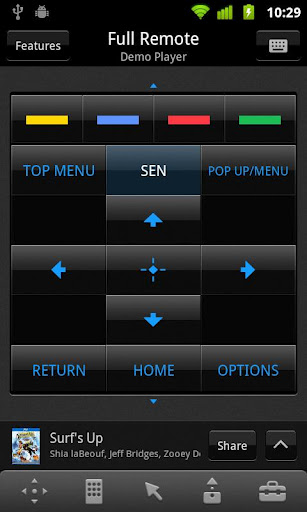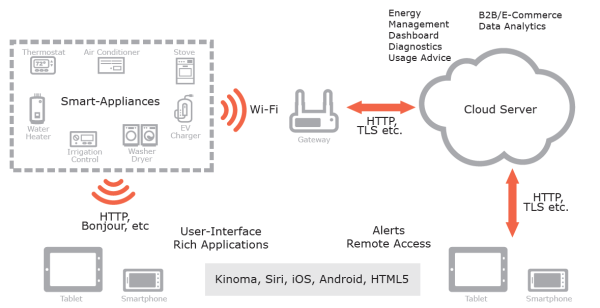Home Automation and the 'Internet of Things'
by Ganesh T S on October 4, 2012 10:30 AM EST- Posted in
- Gadgets
- Home Automation
- Wi-Fi
Technologies such as ZigBee came up in part due to the unsuitability of Wi-Fi, Bluetooth and other such technologies to provide networking with low power consumption, low cost, simplicity and the ability to remain in a suspended state for extended periods of time. Most of the HA technologies were developed when Wi-Fi was unable to satisfy all of these criteria. However, over the last few years, Wi-Fi has slowly, but surely, gained a significant foothold in the home automation industry.
The rise of Wi-Fi's role in home automation has primarily come about due to two factors
- Networked nature of today's electronics: Commonly used electronic devices such as televisions and AV receivers have started becoming part of the home IP network. Even though the networking aspects were added to bring in support for online streaming services or network playback, it became an easy value-add for the manufacturers to expose control of the device functionality over the network.
- Rise of mobile computing devices: The increasing rate of adoption of smartphones and tablets was an added boon. These devices ensure that consumers have access to a portable 'controller' for the electronics connected to the network.
Before proceeding further, I will take a small detour to talk about my personal experience with home automation. Like any other long-time renter, I had no interest in investing money towards fancy home automation solutions. However, as a reviewer of HTPCs and media streamers, I had often used the streamers' Android remotes / XBMC web & Android remote for playback control using my smartphone. I had also installed Sony's remote for my KDL46EX720 TV on my Android smartphone, but rarely got the chance to use it. I realized the full benefit of the Android remote when I found that I could switch on / mute or reduce the volume on the TV without being in the same room.

Sony's Android Remote: Whetting the Appetite for Home Automation
In scenarios such as those outlined above, consumers don't realize that they are actually using some form of HA. The Wi-Fi network already fulfills the basic requirements of a HA system without any extra expenditure on the part of the consumer. For any technology to succeed amongst consumers, price is key. Wi-Fi practically turns out to be free for HA purposes. Hence, it will not be a surprise if home automation with Wi-Fi finally manages to catch the attention of consumers in a way that current technologies haven't been able to.
Addressing Wi-Fi’s Naysayers
We have been through multiple generations of Wi-Fi since the first 802.11-based consumer products appeared in 1999. With maturing technology, the cost of Wi-Fi radios has gone down. They have also become simpler to integrate into systems. At the beginning of this section, we had outlined the reasons as to why ZigBee was developed as an alternative to Wi-Fi for HA purposes. We see that some of these issues have already been addressed. Power consumption and reliable range, however, remain a problem. Towards this, the 802.11 group is working on a new standard, 802.11ah. Expected to be ratified around May 2015, its main purpose is the creation of a sub-1 GHz sensor network. Smart metering is one of the intended applications, but home automation should not be far behind. 802.11ah should help address any shortcomings of current generation Wi-Fi for HA purposes.
Silicon Vendors Target Fast-Growing Market
The primary requirements for the wireless communication modules in these HA devices are:
- Low power MCU integrated in the module along with networking stack
- 802.11 b/g support (802.11n is not strictly necessary)
- Small form factor and full industrial temperature range (-40C to 85C)
- Small host footprint in terms of Flash and RAM requirements
We have a number of Wi-Fi radio makers targeting this embedded Wi-Fi market. TI has the CC3000, launched in January 2012, which is part of LSR’s TiWi-SL self-contained Wi-Fi module. Marvell also launched the 88MC200 microcontroller in January 2012. It is tied along with the Marvell Avastar 88W878x Wi-Fi radio SoCs for smart energy platforms.
Marvell's Pitch to Customers Integrating Wi-Fi in Smart Appliances (The concept remains the same with Wi-Fi modules from other vendors too)
Qualcomm Atheros launched the AR4100P Wi-Fi System-in-Package for the home automation market in March 2012. The AR4100P is a 802.11n single stream Wi-Fi system-in-package with an integrated IPv4/IPv6 TCP/IP stack. Board vendors such as RTX deliver pre-built cards based on the AR4100P along with software support.
If WiFi has to replace specialized HA protocols in simple switch type devices, it has to offer a significant cost advantage at installation. Obviously, support for more than 256 nodes has to also be provided seamlessly in a user friendly manner. Current HA controllers already integrate a hybrid of technologies using different standards where it makes sense (W-iFi + Z-Wave, Insteon or Zigbee). This will be a continuing trend till 802.11ah gains consumer acceptance and everyone realizes that specialized protocols serve no purpose. However, this is quite some time off and it is a concern only for people who have already invested in a HA standard. People starting to explore home automation options simply can't go wrong by choosing a pure Wi-Fi based one.
In this section, we saw control of the media center as one of the HA examples using Wi-Fi. Conventional HA systems include control of power switching, lighting, HVACs and home security systems. In the next few sections, we will take a look at some of the interesting Wi-Fi based HA devices.











54 Comments
View All Comments
southpaw42_i - Thursday, October 4, 2012 - link
Electric IMP looks to become big Home automation over next few years.Product developer will be able to add HA WIFI features to their products without the needed support cost of a managing the connection and the service themselves or the FCC validation of each product..
http://electricimp.com/
ganeshts - Thursday, October 4, 2012 - link
Looks like a very interesting product. I will be sure to investigate.jamyryals - Thursday, October 4, 2012 - link
Thanks for the article Ganesh, very interesting and I agree that this technology is starting to get more accessible. However, I must disagree with the statement that it's not possible to recommend products that do not have a documented API. Nest works great for me standalone. Why would the average customer need to connect it to anything else? My sprinkler system is automated as well. It won't turn on if it has rained. The automated door locks will open when I approach with my cell phones. I think the simplicity and predictability in how these devices operate is key for mass consumer adoption.I am a developer so there's nothing technologically in this realm that has stopped me from automating my house in the past. It's practical matters; cost and me becoming on call support in my own house. Anytime the lights don't come on the way they are expected to I'll have to go troubleshoot my devices/scripts.
If we had our wish we would get both simplicity and ultimate control. That's just not the way the consumer behaves though. Consumers will avoid poorly designed products that tout open APIs as a major selling point. People want things that work and they can understand.
ganeshts - Thursday, October 4, 2012 - link
I don't disagree with you on the point that Nest is a great device. If it were not, it wouldn't have achieved this much success.Products such as Radio Thermostat CT-30 and those from Visible Energy barely make a mention of open APIs in their marketing material. So, it is not that they 'tout it as a major selling point'. My intention, as a tech journalist, is to point out where products can improve. In that respect, I am a cynical customer for most of these companies.
To take the computing analogue, many users are satisfied with the Apple ecosystem, but there are a number of users out there who stand by Android for its open nature. Some journalists recommend and stand by Apple's products, while others are on the Android side of things. Both of them have a place in the market. Similarly, devices such as Nest will be popular in the market for some time to come because 'they just work' and people are enamoured by the appearance and usability. Just as Android continues to grow, devices which open up for ultimate control will give consumers better choices (particularly for the tech audience that makes up a majority of AT's readers).
Publications like Engadget, Gizmodo, Verge, AllThingsD (WSJ) provide lots of attention to products like the Nest. As a tech journalist for AT, I consider it my job done if consumers are at least made aware of the other more flexible options available.
bobbozzo - Friday, October 5, 2012 - link
"Nest works great for me standalone. Why would the average customer need to connect it to anything else?"I'd like to have my house open the windows and turn off the A/C when the temperature drops in the evening, and I'd prefer to do it with one application. I can program, but I'd rather have something available off-the-shelf.
shalomo1 - Sunday, October 21, 2012 - link
I am currently working on a project about home automation, I would like to meet and share ideas with you. this is my mail abraham.o@aol.com. ThanksCSMR - Thursday, October 4, 2012 - link
Good to have an article on this.Unfortunate that if there's a conclusion, it's that WiFi will become a suitable technology in 2015 with 802.11ah.
Very little is even known about 802.11ah. It's too early to say what it is, let alone whether it will take over low power networking.
I agree that: in the future, a low power wireless networking standard suitable for home automation will be standardized by IEEE and be called 802.11something.
Maybe there will be so many connected low-power devices that the new standard will be integrated into many wireless access points and routers.
What is unfortunate is that it will take years for this to happen.
ganeshts - Thursday, October 4, 2012 - link
Hmm.. low power Wi-Fi is only needed in a subset of HA devices. As I pointed out in the piece, there are already plenty of Wi-Fi based HA products and silicon vendors are providing low power platforms even with current Wi-Fi technology.noblemo - Thursday, October 4, 2012 - link
Bluetooth 4.0 Low Energy (BLE) is another protocol worth mentioning. It is a low-bandwidth, low-power technology that enables users to communicate directly to a device using a smartphone or tablet without the need for a separate controller or network connection. A self-contained sensor pod including a BLE module and battery can fit within a package about the size of a stack of six or seven 25-cent coins.In a pre-802.11ah world, Wi-Fi is better suited to high bandwidth or web-enabled devices with external power. In practice, I expect to see hybrid solutions using Wi-Fi and a second technology for remote, low power devices.
Chapbass - Thursday, October 4, 2012 - link
Hey, just wanted to take a moment to recognize Ganesh for his work. I know a lot of people are on the mobile device bandwagon and all of that, but I consistently find Ganesh's work to be unique, informative, and incredibly refreshing to this site.Keep it up, love reading it!